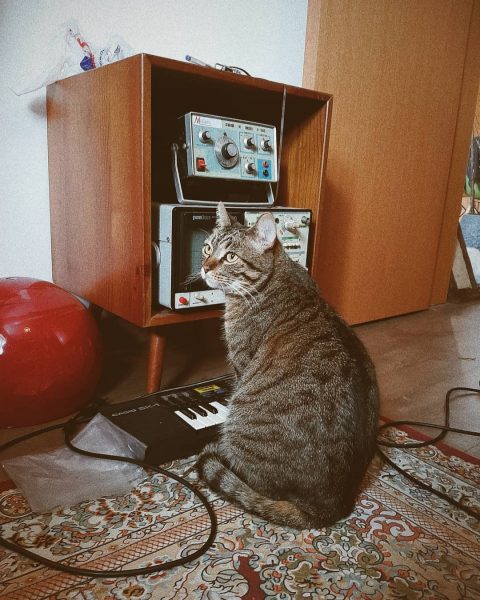
A really sweet photo from the vault of our friend Kamal Sabran.

A fun little jam from our friend Kamal Sabran and his cats. Watch for a close-up of our non-plussed feline friend grooming right through the jam. I like the way the drum sounds and rhythms have been chopped up with loops, delays, etc. And as always, I’m curious about what the reel-to-reel is contributing.
It’s always fun to check in with our friend Kamal Sabran as he jams in his unique studio with his cats. We see a Behringer Neutron, a Roland SP-404SX, a vintage Ace Tone Rhythm Fever, an analog oscilloscope, and reel-to-reel. I’m definitely curious about what the reel-to-reel tape is contributing to the music in this jam.
We always love checking with Kamal Sabran and his cats – and we love cats in the studio. But sometimes things don’t go as planned. Watch to the end 😹
Kamal Sabran’s cats have appeared several times on CatSynth. This time, human and cat are together as they work on some experimental tracks. We see a Roland SP-404SX sampler/sequencer, a Behringer Neutron, a vintage Ace Tone Rhythm Fever, an analog oscilloscope, and an analog reel-to-reel tape recorder.
Check out their new album and more at spacegambusexperiment.bandcamp.com.

This cat is posing proudly with a Casio SK-1 sampling keyboard, an analog oscilloscope, and a function generator. From felipe_ayres on Instagram.
Keyboard cat 😽🎹
This has to be one of the sweetest things we have seen in a long time! From our friend Kamal Sabran via Facebook. We see a young man and young cat, who clearly love one another, playing a drum machine. There is also an Arturia MicroBrute, a Korg Kaoss Pad, and some cool retro devices including a reel-to-reel tape recorder and analog oscilloscope.
Via matrixsynth:

Originally from gerald:
My cat loves the Lissajous this thing generates
So what is a “Lissajous”? it is actually short for Lissajous curves or Lissajous figures, a class of 2D (and 3D) curves describing complex harmonic functions, or more simply multi-dimensional sine curves. The following equations describe a general Lissajous curve on an x-y coordinate plane:
x = A sin(at + φ)
y = B sin(bt)
Most of the time, one leaves out the A and B, which case all the curves fall on a convenient unit square.
The most commonly described Lissajous curves set the phase term φ to π/2, i.e., a standard cosine function, and have a and b at integer ratios, like 1:2, 6:5, etc. You can think of these as natural harmonics, like in musical sounds. You can see a few of the graphs below, first for a=1 and b=2:
Here are 3:2 (a:b), and 9:8, respectively:
As you can see, the higher the ratio, the more complex and dense the figure. If you add all the figures up together, you should be able to fill the entire unit square.
There are all sorts of interesting special cases. For example, if you set a and b equal, you will get a circle. If you additionally set the φ to zero, you will get a straight line. Finally, you can mess with different values of φ, like 0.3 in the first drawing below, or set a and b to non-integer values, to get all sorts of interesting variations:
It is interesting to think about these sorts of functions by relating them both visually and aurally (i.e., synthesizing the corresponding waveforms), but we will leave that as an exercise for interested readers, perhaps returning to the topic in a future article.
cat
synth
oscilloscope
lissajous
harmonic functions
graph
Trying a little experiment. Trackposted to Gone Hollywood, Conservative Cat, The Crazy Rants of Samantha Burns, and The Pet Haven Blog, thanks to Linkfest Haven Deluxe. The links here and in the trackbacks do not necessarily reflect the opinions of this site or its contributors.